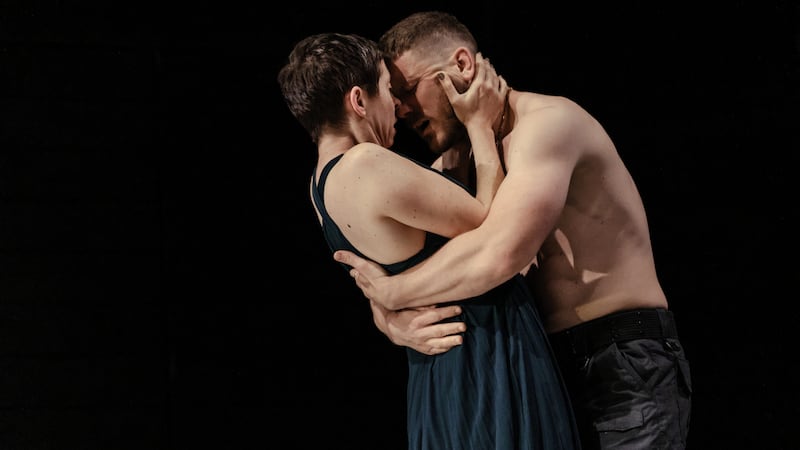Marriage. Mother love. Midlife crises. These are themes that simmer in the subtext of all plays by Marina Carr. What does it cost to twin one life with another? What are the sacrifices we make as individuals for the greater good of our relationships, for stability? From plays such as By the Bog of Cats, inspired by the Greek myth Medea, to her most recent work, Girl on an Altar, a version of the Oresteia, familiar intimate questions are played out on an epic scale.
Girl on an Altar premiered at London’s Kiln Theatre last year, in a co-production with the Abbey Theatre, directed by Annabelle Comyn. As the writer and actor prepare for the Irish premiere, they divulge the details of their working relationship and their shared belief that “the ideas within the play, the politics of it, are quite universal”, as Comyn expresses it.
The play is set at the end of the Trojan War, but “it resonates so much with what’s going on in the world – in Afghanistan, in Saudi Arabia, in Ukraine – but it is also about more than that. It is about relationships, love, grief: being human.”
Carr is speaking from her room at the Centre Culturel Irlandais in Paris, where she has taken a few weeks to complete some writing projects. A concert is happening in the courtyard outside and she flits in and out of coverage during the conversation, chiming in to offer her perspective as Comyn describes the genesis of the production. Comyn has just arrived home after a day’s rehearsal in Dublin, and she brings an intensity to the meeting that belies a day spent talking about character motivation and movement with actors.
RM Block

The pair have known each other for years. From Irish theatre circles, of course, but also from the Lir Academy, where Carr has taught on the MFA in playwriting and where Comyn serves as head of the MFA in theatre directing. However, they only worked together for the first time in 2021, on a production of To the Lighthouse, an adaptation by Carr of Virginia Woolf’s novel, which managed to thrill audiences despite Covid limitations that dictated a digital stream rather than a live iteration. The production had actually been in gestation for more than five years, and the aesthetic care of the two artists was evident in Carr’s careful dramaturgical construction, as well as Comyn’s artful and measured directorial approach.
So, when Comyn was invited by the Kiln Theatre to direct Girl on an Altar, the director “felt instantly excited, even before reading it. To be honest, if someone comes and says would you like to do a new Marina Carr play, you will just do it. Bar To the Lighthouse,” she says, “I hadn’t had the opportunity to direct her work, so I was excited about the idea of how I might approach it, and when I read it ... her images were so visceral and alive with this language that is so muscular, so full of complexity and tenderness.
“She was dealing with such large political themes but there are these personal themes held in tandem, and how she keeps the two feeding off each other ... I just thought, this is extraordinary.”
Comyn was also attracted by the fact that the play seemed to offer a blank slate to its director. “There are almost no stage directions in the play,” she says, “and that seemed to me to be an extraordinarily generous thing. There is a trust there and that trust is very freeing.” The challenge then was finding a physical form for the story on stage.
Girl on an Altar is the story of a marriage disintegrating. War hero Agamemnon has just returned home to his wife Clytemnestra after 10 years fighting in Troy. His victory was predicated upon a special sacrifice he made to the gods: the life of his daughter Iphigenia. The fated reunion is a fraught one, as the married couple each try to reckon with the consequences of their actions: Agamemnon, his filicide; Clytemnestra, her infidelity and her failure as a mother.
As Comyn describes it, the play “is the epic meeting the domestic, but it’s not set in a kitchen, it’s not set in a room”.

What Comyn as director and Tom Piper as designer needed to find was the best visual language to match the heightened world that Carr had created in her play.
Comyn was inspired by the ancient source material to think of the present reality of the drama unfolding as a landscape on which the world has been built: “How wealth and power can be built on top of atrocities, where the use and abuse of vulnerable people is something we build a power base on. We never really look where our wealth comes from, what props it up, until times of crisis. So the play addresses this idea of what we do in order to perpetuate power, the foundations of our privilege.”
Despite the play’s ancient context, Comyn argues: “We can really read it in terms of what is going on now in the world, in terms of the colonisation of people, but also how ravaged our landscape is: what we have drawn from it without consideration of the damage we are doing. So this ancient past feels very contemporary: you think, how very little has changed in those millennia.”

This immediacy gets to the heart of Carr’s interest in Greek myth, which she first read as a child in the abridged Ladybird compilations in the 1970s: Hercules, Jason and the Argonauts. She was attracted, she says, by the characters “living out their passions and the consequences of those passions”. For Carr, the fascination was rooted “not in how larger than life the characters were, but how small they were, how they were defined by their greed, their ambition, their inability to let a thing go.
“What strikes me always is how little we have changed since some of those first stories were written: we are not sacrificing children on altars, but we are still sacrificing children, make no mistake. We are still doing it, just more secretively. We are quite fortunate [in Ireland] in that we live in a relatively stable part of Europe – for the moment – but if you look backwards: our grandparents came out of civil war and if you think about that, what was happening village to village, these passions are not remote. In terms of the hard-wiring, the blueprint of what we know about being human: we are not far from the cave, from the Greeks, from what was happening in our grandparents’ time, if you scratch the surface. So that’s what I am always thinking [when I am writing]: they are right here.”
[ Marina Carr: ‘There’s a whole world of women’s work that isn’t being seen’Opens in new window ]
Having composed a variety of plays inspired by those stories – from the more allusive resonances of Bog of Cats to the more explicitly referential Hecuba – Carr says her interest as a writer “always starts with the micro: with people. Men, women, children: what they feel, what they say, how they behave.”
The epic reach of that work occurs, she says, as “a collection of small moments. If you try to write an epic you will fall on your face. But if you look at people, and what they do to each other, the result may or may not be an epic; it is out of your control.”
What is within a writer’s control, however, is the production of their work, and Carr and Comyn have a simpatico relationship, in which they have managed to achieve both a sense of urgency and timelessness in their staging of the ancient story, as Clytemnestra tries to come to terms with her husband’s actions and her failures as a mother; as Agamemnon attempts to cope with the consequences of the private sacrifices he made for political gain.
As Carr observes in her poetic script: if we cannot identify with the dramatic height of their actions, we must concede that they “are clay like the rest of us”.
Girl on an Altar runs at the Abbey Theatre from July 8th to August 19th





















